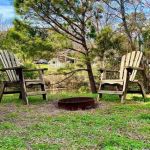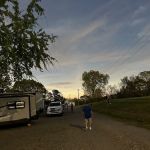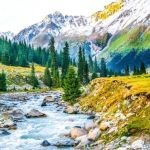Why Guidebooks Still Matter in U.S. National Parks
The best guidebooks for US National Parks do something your phone can’t always do: work flawlessly when cell service disappears and help you make great decisions without doom-scrolling. In Yellowstone, for example, you can drive thirty minutes with zero bars, and that’s exactly when a printed mile-by-mile map, a campground chart, or a wildlife-viewing timetable becomes gold. Beyond logistics, good guidebooks curate—prioritizing which geyser basins to see at sunrise, which Zion shuttle stops are worth hopping off for family-friendly hikes, and how to time Acadia’s Park Loop Road to miss the crowds. The result is less guesswork and more actual time outside.
Another reason guidebooks matter: context. A two-page spread on Yosemite’s granite history or the human story of the Great Smoky Mountains can change how you experience a viewpoint. When a book places a viewpoint inside a narrative—how the valley formed, which Native nations stewarded the land, why a trail zigzags where it does—you travel with fresh eyes. That context also keeps your itinerary realistic; distances in the West are not “as the crow flies,” and elevation gains feel different at 8,000 feet. A trusted book anchors expectations so your trip flows rather than frays.
Who Does What Best: Fodor’s, Moon, Lonely Planet, Nat Geo & Others
Fodor’s shines at polished overviews and trip planning for first-time visitors. Think clear “must-see” rankings, smart dining suggestions just beyond the park boundary, and hotel picks that balance style with location. If you want a broad, confidence-building sweep with polished maps and seasonal tips, Fodor’s is a strong start.
Moon guidebooks are beloved for practical detail and author voice. Many titles are written by long-time locals or experts who include exact drive times, sunrise/photography notes, and less-obvious viewpoints. Moon’s “Best Hikes,” “Best for Families,” and “Avoid-the-Crowds” callouts are trip-savers in peak season.
Lonely Planet gives you a backpacker-friendly, budget-conscious angle while still covering the big sights. If you’re stitching parks together on a long road trip—say Grand Canyon, Bryce, Zion—Lonely Planet’s concise logistics and town rundowns work well.
National Geographic pairs evocative photography with expert cartography. Their park maps are gorgeous and accurate, and their guidebooks bring the natural history alive. If you’re a visual learner or traveling with someone who gets inspired by images, Nat Geo editions can flip inspiration into action.
Falcon Guides and other trail-focused imprints (including local hiking clubs) are essential when your trip revolves around hiking. Expect granular trail stats, topo lines, and clear difficulty ratings. These pair perfectly with a generalist book like Fodor’s or Moon.
Matching the Book to the Park: Yellowstone, Yosemite, Zion, Acadia
Yellowstone & Grand Teton: Choose a Moon or Fodor’s for route planning and geyser/wildlife timing, then add a Nat Geo map for on-the-fly navigation. A hiking-specific guide (Falcon) will help you sort safe boardwalk strolls from backcountry treks and understand bear-safety best practices.
Yosemite: The valley looks simple on a map, but congestion and parking rules require strategy. Moon’s author-driven tips for sunrise at Tunnel View vs. sunset at Glacier Point can change your day. Pair this with a detailed trail guide if Half Dome or Clouds Rest is on your radar.
Zion & Bryce: Shuttle systems and permit rules benefit from the succinct breakdowns in Fodor’s or Lonely Planet. If you’re eyeing The Narrows or Angels Landing, a hiking-specific book will clarify gear and water conditions by season.
Acadia: Coastal weather and tide timing matter. Moon and Nat Geo are standouts, especially for photography spots along Park Loop Road and sunrise at Cadillac Mountain. A family-focused book helps mix Carriage Roads cycling with kid-friendly tide pooling.
Maps and Navigation: From Trail Diagrams to Mile-by-Mile Details
In many parks, the right map is the difference between a brilliant day and a backtrack. Nat Geo’s Trails Illustrated maps are durable, waterproof, and detailed. Falcon’s trail diagrams help you visualize elevation gains before you’re huffing them. Meanwhile, generalist guides often include inset maps that show where to park, where bathrooms are, and how to connect trailheads. When you leave cell coverage, these pages become your offline app. Pro tip: tab your book with sticky notes—one for hikes, one for viewpoints, one for food/fuel—and re-check distances every morning. Western parks are vast; a “quick detour” can add 90 minutes round-trip.
Itinerary Design: 1–3 Day Highlights vs Deep-Dive Weeks
Good guidebooks offer multiple time budgets. A one-day Yellowstone sampler might string together Grand Prismatic, Old Faithful, and Lamar Valley at dawn for bison and pronghorn. A three-day plan often alternates high-traffic sights with quieter corners like the Blacktail Plateau Drive. In Yosemite, a weekend can balance valley icons with a sunrise at Taft Point and a quieter afternoon at Tuolumne Meadows (when open). Look for books that label these itineraries clearly, then customize with your energy levels and interests. Couples who love scenic drives may prioritize overlooks; families might schedule shorter hikes with playground-like boulder fields; photographers will chase light, not miles.
Hiking Trails, Seasons, and Safety Essentials
Trail descriptions are only useful if they’re honest about difficulty. The best guidebooks for US National Parks include time estimates, elevation change, and hazards by season—ice in spring, flash floods in monsoon season, wildfire closures in late summer. A trustworthy book will repeat safety essentials: carry water (more than you think), protect yourself from sun at altitude, and respect wildlife distance rules. Seasonality sections are invaluable; Zion’s Narrows feels entirely different in May vs. October, and Acadia’s carriage roads transform with fall colors. Use the book’s seasonal charts to pivot gracefully if weather changes.
Families, Photographers, and RVers: Specialized Picks
Families: Choose Fodor’s or Moon editions that mark playground hikes, junior ranger tips, and picnic spots near bathrooms. A separate trail book with short, shaded hikes pays dividends with kids.
Photographers: Nat Geo and Moon tend to call out sunrise/sunset angles and seasonal wildflowers. Books that list mile-markers for pullouts make golden hour more efficient.
RVers & Road-Trippers: Look for campground charts (hookups, generator hours, rig length limits) and clear notes about propane, dump stations, and steep grades. A Falcon or RV-specific title complements a general guide.
Print vs. Digital: Which Format Works Best on the Road
Print endures because it’s reliable when battery life wanes and signal fades. Digital shines for quick searches, updates, and lighter luggage. Many travelers use both: a print guide for navigation and daily planning, and digital notes for saved restaurant hours or last-minute weather. If you go digital-only, download offline sections and maps. If you go print-only, snap photos of key pages for your pocket so the book can stay dry in the car.
Real Trip Stories: What Actually Helped On the Ground
On a summer loop through Zion and Bryce, a couple used Moon’s shuttle-timing advice to hit Emerald Pools before crowds, then switched to a Falcon trail guide to choose a shaded, kid-friendly canyon walk after lunch. In Yellowstone, a family relied on a Fodor’s itinerary to avoid midday geyser-basin gridlock, then used a Nat Geo map to find a quieter picnic area by the river. These aren’t heroic feats—just the right nudge at the right time. The best guidebooks for US National Parks don’t dazzle with trivia; they quietly remove friction so the wild places can speak for themselves.
How to Choose the Best Guidebook for You
Start with your style. If you crave curated highlights and polished suggestions, Fodor’s is your friend. If you want a conversational expert with deep local knowledge and clear logistics, Moon is hard to beat. If you’re budget-savvy and stringing multiple parks together, Lonely Planet excels. Add Nat Geo for A+ maps and inspiration, and layer in a trail-specific guide if hiking is central. Check the publication date—rules and shuttle systems change—and skim the table of contents for “Best Of” pages that match how you travel: families, photographers, food lovers, or solitude seekers.
Planning with Experts and When to Get Extra Help
Even the strongest bookshelf benefits from human expertise. If your calendar is tight, your group has competing interests, or you want hard-to-get experiences (permits, private guides, special-access photography), pairing guidebooks with professional planning is smart. 【Refined Travel 】 can turn the intel from Fodor’s, Moon, Lonely Planet, and Nat Geo into a seamless, custom itinerary—with timed entries, lodge waitlist strategies, and plan B/C options when weather or crowds shift. That blend—great books plus seasoned advice—delivers trips that feel effortless and personal, exactly what the parks deserve.







 Stadium Village Mobile Home Park4.0 (11 reviews)
Stadium Village Mobile Home Park4.0 (11 reviews) Colonial Ranch RV Park3.0 (7 reviews)
Colonial Ranch RV Park3.0 (7 reviews) Wine Capital RV Park4.0 (23 reviews)
Wine Capital RV Park4.0 (23 reviews) Huron River Mobile Home Park3.0 (41 reviews)
Huron River Mobile Home Park3.0 (41 reviews) Lake Life RV Park5.0 (3 reviews)
Lake Life RV Park5.0 (3 reviews) Powells Mobile Home Park Inc3.0 (67 reviews)
Powells Mobile Home Park Inc3.0 (67 reviews) Exclusive Travel Packages for First-Class Travelers: A Guide to Luxury Vacations
Exclusive Travel Packages for First-Class Travelers: A Guide to Luxury Vacations Refined Travel Experiences in Southeast Asia: Explore Luxury & Unique Destinations
Refined Travel Experiences in Southeast Asia: Explore Luxury & Unique Destinations How to Make the Most of Luxury Vacation Deals: Expert Tips for Savvy Travelers
How to Make the Most of Luxury Vacation Deals: Expert Tips for Savvy Travelers How to Enjoy a Refined Travel Experience in the Mountains
How to Enjoy a Refined Travel Experience in the Mountains Refined Travel Itineraries for Art and Culture Lovers: Explore the World of Art and History
Refined Travel Itineraries for Art and Culture Lovers: Explore the World of Art and History Most Luxurious Destinations for Honeymooners: Top Spots for Romance and Luxury
Most Luxurious Destinations for Honeymooners: Top Spots for Romance and Luxury